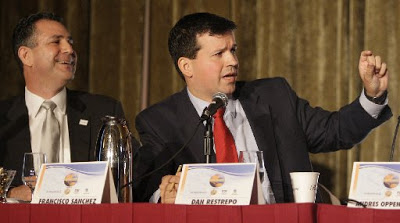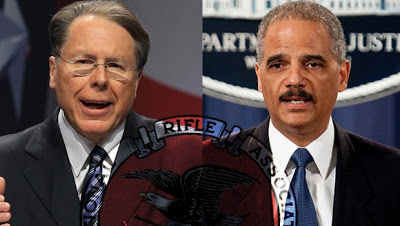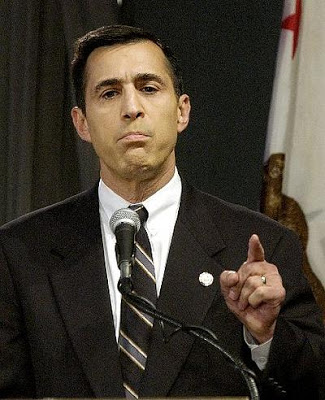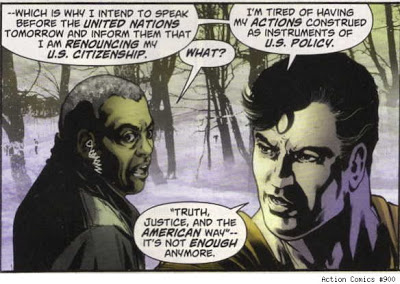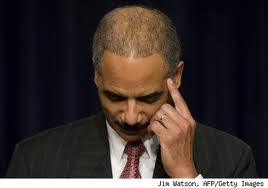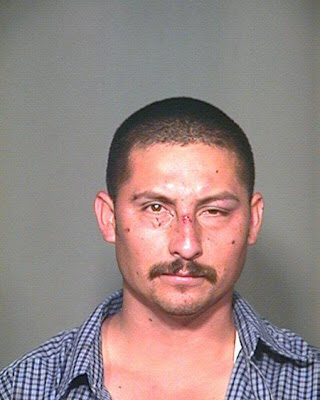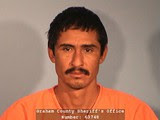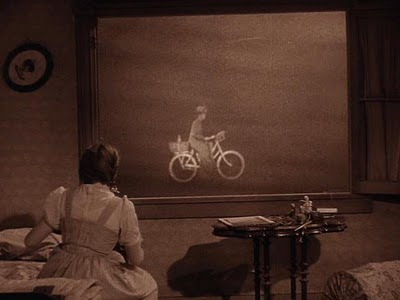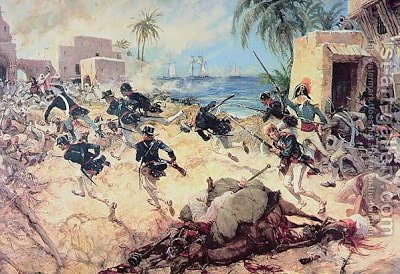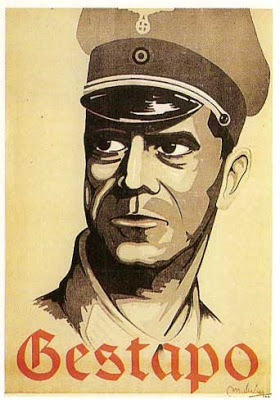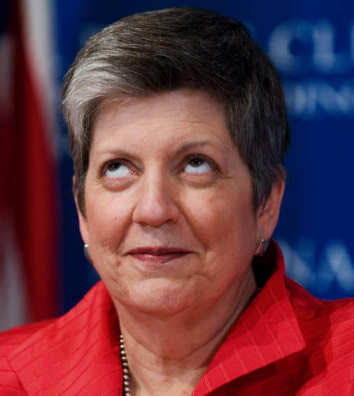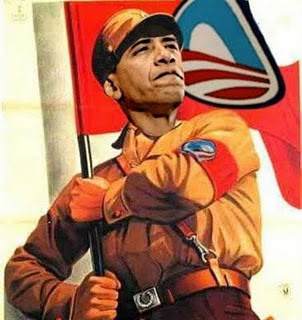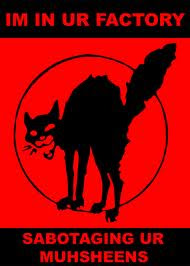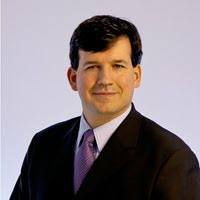
Restrepo's job is to implement Obama's vision for how the U.S. should interact with the other thirty-four countries in the Western Hemisphere. There is no typical workday at the NSC "at least, I haven't found one yet," says Restrepo, and the country or issue he's thinking about switches constantly over the course of each day. He chairs frequent meetings between U.S. federal agencies and foreign visitors, and keeps Obama's national security advisor briefed on matters in the Western Hemisphere that might require the president's attention. -- Penn Law Journal, Spring, 2010.
If personnel is policy and bad policies on the ground come from meetings of ambitious persons on high, then those of us who are trying to figure out where the Gunwalker scandal came from might want to look at Dan Restrepo and the meetings he's been in.
Many readers of Sipsey Street who are familiar with the Obama anti-firearm agenda will recall
this promise from the Obama campaign, entitled “Address Gun Violence in Cities.”
As president, Barack Obama would repeal the Tiahrt Amendment, which restricts the ability of local law enforcement to access important gun trace information, and give police officers across the nation the tools they need to solve gun crimes and fight the illegal arms trade. Obama and Biden also favor commonsense measures that respect the Second Amendment rights of gun owners, while keeping guns away from children and from criminals who shouldn't have them. They support closing the gun show loophole and making guns in this country childproof. They also support making the expired federal Assault Weapons Ban permanent, as such weapons belong on foreign battlefields and not on our streets.
Fewer readers will be familiar with Obama's campaign promises about Mexico, and even fewer will recognize the name of his campaign point man then and Special Assistant to the President and Senior Director for Western Hemisphere Affairs on the National Security Council now: Dan Restrepo.
The Bolívar Network of the University of Virginia ("an inclusive alumni organization dedicated to reaching out to and advocating for all Latinos, Hispanics and Latin American birth, origin, or affinity alumni, students and friends of the University of Virginia's Latino community by connecting to each other and to the University") described Restrepo, Class of 1993, before he took up his jobs with Obama thusly:
Dan Restrepo is a Senior Fellow and Director of The Americas Project at American Progress. In his role, Dan is responsible for the Center’s work related to the United States and its place in and relationship with the rest of the Americas. Dan, a first generation American of Colombian and Spanish parents, served on the Democratic staff of the House International Relations Committee from 1993 to 1996. There he focused on all aspects of U.S. policy toward Latin America and the Caribbean, including U.S. policy toward Haiti during its political transitions, U.S. counter-narcotics programs and policies, the consolidation of the Central American peace processes, U.S.-Cuba policy, and the Mexican debt crisis among other matters. During his tenure on the International Relations Committee staff, Dan traveled extensively throughout the hemisphere meeting with government officials, civil society leaders, and opposition party leaders.
Immediately before starting The Americas Project, Dan served as the Director of Congressional Affairs at American Progress. Prior to joining American Progress, Dan spent three years as an associate at the law firm of Williams & Connolly, LLP. (Emphasis supplied, MBV) Prior to those years, Dan served as an attorney for the Florida Democratic Party during the 2000 election recount. From August through November 2000, he worked as the Research Director for the Florida Democratic Coordinated Campaign. . .
Dan graduated magna cum laude from the University of Pennsylvania School of Law (1999) before serving as a judicial clerk to the Hon. Anthony J. Scirica of the United States Court of Appeals for the Third Circuit. Dan graduated from the University of Virginia in Charlottesville, VA (1993). He speaks fluent Spanish.
Another
Restrepo profile.And what is
Williams & Connolly?Williams & Connolly LLP is a prominent litigation firm based in Washington, D.C. The firm was founded by trial lawyer Edward Bennett Williams, who left the partnership of D.C. firm Hogan & Hartson to launch his own litigation boutique.
Recent high-profile cases include the successful defense of U.S. President Clinton's impeachment, representation of Enron's law firm Vinson & Elkins, representation of the motion picture studios in the Kazaa/Grokster file-trading litigation, defense of the Vioxx cases, and counsel for the plaintiff states in the United States v. Microsoft antitrust remedy trial.
In past years the firm represented Colonel Oliver North during the Iran-Contra Affair, and defended John Hinckley, the would-be assassin of President Reagan, and President Clinton during the impeachment hearings. The firm's senior partner is Brendan Sullivan. -- Wikipedia.
Oliver North. Pretty ironic.
The law firm lists this litany of descriptions of themselves on the sidebar of their website:
"Williams and Connolly likes to save itself for clients in mortal danger." -- The American Lawyer
"The powerhouse Washington law firm with a deep bench." -- Wall Street Journal
"Williams & Connolly, the Washington power law firm." -- Washington Post
"A reputation for fierce representation of its high-profile clients." -- National Law Journal
"One of the city's most prestigious and feared law firms." -- The New Republic
"Tightly knit, highly trained, and notoriously relentless." -- Legal Times
"Washington D.C.'s Williams & Connolly is one of the most prestigious firms in the country - and one of the most tight-lipped." -- Vault.com
I guess it ain't braggin' if you can do it.
W&C describes their own successes in
International Litigation and Arbitration:Williams & Connolly LLP has represented numerous clients in a wide range of international disputes. The firm has been recognized as one of the top 10 firms in the United States for International Commercial Litigation in a survey of corporate counsel and peer firms conducted by Euromoney and awarded the top honor as the only leading law firm for dispute resolution in Washington, D.C. by the PLC Global Counsel Dispute Resolution Handbook (2004-2005 edition). Whether in litigation, arbitration, or negotiation, Williams & Connolly attorneys bring to international disputes the same traditions of top-notch preparation, strategic thinking, and concern for the client's goals as in the firm's domestic litigation practice.
The firm is frequently retained to represent both foreign and U.S. clients in litigation in foreign countries as well as in litigation spanning two or more national jurisdictions. Firm lawyers manage all aspects of such proceedings to ensure a unified, consistent approach. For example, when a Bermuda company confronted a series of disputes over an investment it made in Chile with
co-investors from Chile, Canada, and the United States, Williams & Connolly lawyers directed litigation strategy in each of the relevant countries with close attention to the legal regimes and customs of each country and careful oversight of how developments in one country would impact strategy in the other countries.
The firm's attorneys have represented clients involved in disputes
all over the world, including:
Europe - Belgium, Denmark, France, Germany, Greece,
Holland, Hungary, Italy, Spain, Switzerland, the United
Kingdom, Ukraine, Bulgaria, and the former Yugoslavia
Asia and the South Pacific Region - China, Indonesia,
India, Japan, Philippines, Russia, Taiwan, Thailand, and
Australia
Middle East - Bahrain, Israel, Morocco, Saudi Arabia, and
the United Arab Emirates
Americas - Argentina, Bermuda, Bolivia, Brazil, British
Virgin Islands, Canada, Chile, Colombia, Costa Rica,
Ecuador, El Salvador, Mexico, (Emphasis supplied, MBV) Panama, Peru, Uruguay, and Venezuela
Africa - Congo (Brazzaville and Kinshasa), Madagascar, São
Tomé and Principe, and South Africa
W&C has some powerful partners, including
Clinton impeachment lawyer Gregory B. Craig (as was Lanny Breuer, DOJ Gunwalker conspirator). Craig made headlines when he became one of the first of the Clinton camp to endorse Obama, and the ABA Journal predicted in its November 2008 edition that Craig would be named Secretary of State in an Obama administration. However, Craig was ultimately appointed as White House Counsel in the administration, a post he later resigned, supposedly being forced out because of his role in advising Obama to close Guantanamo Bay by January 2010, a task that could not be achieved. His resignation became official on 3 January 2010.
Other high-power partners include
Kevin M. Downey and
David D. Aufhauser. Aufhauser's official bio states:
His areas of practice include arbitration and mediation, litigation, financial services counseling, Patriot Act and FCPA compliance, OFAC and CIFIUS related matters, and legislative and executive branch investigations.
David has previously served as a Managing Director and Global General Counsel of the UBS AG investment bank, and as the General Counsel of the U.S. Department of Treasury, supervising the Department’s legal functions in International Affairs, Domestic Banking and Finance, Enforcement, the Internal Revenue Service, the U.S. Bureau of Customs, the Office of Foreign Asset Controls, the Secret Service, ATF, the Financial Crimes Enforcement Network and the U.S. Mint.
David currently serves as a senior adviser at the Center of Strategic & International Studies (CSIS), a member of the Council on Foreign Relations, an executive committee director of the Atlantic Council, a trustee of the St. Albans School of Public Service, and has served on the Global Markets Advisory Board of the U.S. government’s National Intelligence Council.
Altogether as serious bunch of players as you will find in the District of Criminals. And Restrepo apprenticed at the knees of these power brokers for three years.
On 12 November 2008, Restrepo, then Obama's chief campaign adviser on Latin American affairs,
was interviewed by Processo's J. Jesús Esquivel on "What Obama wants in the U.S. Relationship with Mexico."
Restrepo maintains that Obama is concerned, and to a degree annoyed, that the Mexican people are paying the consequences for decisions made by the government of George W. Bush in the struggle against narcotics trafficking: abandoning programs to reduce drug use, and not allotting more personnel nor economic resources in order to restrain illegal activities in the United States that help organized crime and narcotics trafficking from the other side of the southern border.
"Obama wants first to decrease the demand for drugs in the United States. He is firmly determined to do that which is necessary in order to revitalize the rehabilitation programs that, we well know, work, and that unfortunately have been abandoned in recent years," he emphasized.
Then "we will work to inhibit the flow of weapons, cash and stolen vehicles that go from north to south across our border." (Emphasis supplied, MBV) That is, Restrepo explained, "he wants to close those flows that feed narcotics trafficking," that too have caused the violent struggle of the drug cartels in Mexico for transit routes to the United States."
On 9 January 2009,
(Wikileaks reveals) a secret State Department cable warns the new administration of increasing threats by the cartels to U.S. law enforcement. Very prescient in the light of the deaths of agents Terry and Zapata:
R 232312Z JAN 09 ZDS
FM AMEMBASSY MEXICO
TO SECSTATE WASHDC 4721
INFO ALL US CONSULATES IN MEXICO COLLECTIVE
DEPT OF JUSTICE WASHINGTON DC
DEPT OF HOMELAND SECURITY
NATIONAL SECURITY COUNCIL WASHINGTON DC
HQ USNORTHCOM
CIA WASHINGTON DC
CDR USSOUTHCOM MIAMI FL
DEPT OF TREASURY WASHINGTON DC
NSC WASHINGTON DC
S E C R E T MEXICO 000193
NOFORN
E.O. 12958: DNG: CO 01/22/2019
TAGS: PREL PGOV PHUM PINR SNAR KCRM MX
SUBJECT: THE BATTLE JOINED: NARCO VIOLENCE TRENDS IN 2008 . . .
U.S. Personnel and Institutions Targets?
----------------------------------------
¶12. (C) We have observed a significant up-tick in threats, as well as incidents of surveillance, against USG personnel and properties over the last three months. All threats are treated seriously and precautions taken; fortunately, none has come to fruition.
¶13. (S/NF) On October 12, unknown persons fired gunshots and tossed an un-detonated grenade at the U.S. Consulate in Monterrey. The attack occurred after hours, no one was injured, and little damage occurred. No message was left and we have uncovered no useful intelligence regarding the authors or their motives. One unsubstantiated report cited a source claiming a senior Gulf cartel leader ordered the attack. However, with little hard evidence, no attempt to claim credit and no follow on incident to date, the possibility remains that this was an isolated, possibly even
impulsive, attack not likely undertaken at the behest of senior cartel leaders.
¶14. (C) While the cartels have not yet directly targeted USG law enforcement or other personnel, they have shown little reticence about going after some of our most reliable partners in Mexican law enforcement agencies. Ten close DEA law enforcement liaison officers have been killed since 2007, seven of whom were members of Special Vetted Units. Similarly, within the past two years 51 close FBI contacts have been murdered. More than sixty of Mexico's best law enforcement officers in whom we have placed our trust and with whom we have collaborated on sensitive investigations,
shared intelligence and in many cases trained and vetted have been murdered by the cartels. We do know from sources that cartel members have at least contemplated the possibility of doing harm to both our personnel and institutions, but we frankly don't know enough about how DTO members think and operate to know what factors might trigger a decision to mount such an attack, but the potential threat is very real.
¶15. (C) We assess that the threat to U.S. personnel could increase if the violence continues to escalate and more high-level government officials and political leaders are targeted. Also, a reaction may be triggered if traffickers perceive their losses are due to U.S. support to the GOM's counter-narcotics efforts. We will continue to monitor potential threats to U.S. personnel from organized criminal gangs and be alert to information that suggests drug traffickers increasingly see the U.S. hand as responsible for their losses.
On 25 February 2009, Attorney General Eric Holder announced the Obama administration’s appetite for a new “Assault Weapons Ban” and was
immediately slapped down in public by Democrats including Nancy Pelosi and Rahm Emanuel.
On 25 March 2009, Secretary of State Clinton conferred with Mexican President Calderon.
A
secret State Department cable that was posted on Wikileaks reveals that in the room for the U.S. were Clinton; Charge D'affaires Leslie Bassett; Assistant Secretary of State for Western Hemisphere Affairs Thomas Shannon; Laura Pena, Senior Advisor to the Secretary of State; and
Dan Restrepo, Senior Director, National Security Council. (Emphasis supplied, MBV.) Mexico was represented by President Calderon, Foreign Secretary Espinosa, Ambassador to the U.S. Sarukhan, Under Secretary Rico and Presidential Advisor Fernandez de Castro.
From the cable Summary: “During an extremely cordial conversation with Secretary Clinton, President Calderon emphasized his personal commitment to providing security for Mexican citizens,
pressed for greater U.S. actions against arms trafficking, (Emphasis supplied, MBV) conveyed concerns about how the issue of Cuba will be treated at the upcoming Summit of the Americas, and discussed his ideas for global action on environmental issues.”
The cable details:
6. (C) President Calderon acknowledged that our agenda is broader than security, but turned to that topic as the most urgent. His personal commitment was to leave his successor a secure Mexico with credible institutions free of the taint of corruption. To succeed he needed U.S. support, and suggested renewing the assault weapons ban.
He said that there was a clear correlation between the lifting of the ban in 2004 and Mexico's current situation. During the six years of the Fox administration, Mexican forces captured 3,000 assault weapons. In the last two years, they confiscated 16,000, with no end in sight. The availability of assault weaponry had contributed to the cartels' new aggression against government forces. A second factor was cartels' expanding interests. While they still fought for access to the U.S. market, they were increasingly seeking to control the growing Mexican drug market, as well. The combination of assault weapons and an increased imperative for geographic control prompted the dramatic increases in violence Mexico had recently witnessed. The third factor was the Mexican government's increased pressure on the cartels. . .
10. (C) Secretary Clinton responded that her message was one of co-responsibility and cooperation. She was personally committed to making sure both countries succeed. The United States would do its share. In the coming weeks, AG Holder and DHS Secretary Napolitano would visit Mexico to further this important dialogue.
The Obama Administration had announced on March 20 a series of new measures along the U.S. border to impede smuggling or arms and cash into Mexico. The Secretary said she could not be confident that an assault weapons ban would be passed by Congress, but she was confident the Administration would use every means to aggressively enforce existing law. (Emphasis supplied, MBV.) She offered to share ideas with Mexico on demand reduction in both countries. She affirmed the Administration's absolute confidence that Calderon would succeed in his efforts, and that the United States would be with him every step of the way.
The day before, on 24 March 2009, Jackie Vega of the Associated Press, reported:
"Gun debate crosses into border struggle
Possible solution hangs over U.S.-Mexico violence."Congress may be alarmed by the surge in Mexican drug violence and its potential to spill across the border, but its members grow silent when the talk turns to gun control as a solution.
With related kidnappings and killings occurring in the United States, the Obama administration is likely to shift dozens of enforcement agents and millions of dollars to the fight against Mexican drug cartels. . .
However, when Attorney General Eric Holder suggested reinstituting a United States ban on the sale of certain semiautomatic weapons, many lawmakers balked. The 1994 ban expired after 10 years.
Mexico has long tried to get the United States to curtail the number of guns, many purchased legally, that wind up south of the border where gun laws are much stricter. The State Department said firearms obtained in the United States make up an estimated 95 percent of Mexico's drug-related killings.
Yet, when border violence comes up in hearings, lawmakers said they do not see a need for new gun laws. Sen. John Cornyn of Texas heads the GOP's Senate election committee.
"I don't think the solution to Mexico's problems is to limit Second Amendment gun rights in this country," said Cornyn. . .
Federal officials said the president's effort to shift dozens of enforcement agents and millions of dollars to the fight against Mexican drug cartels is not a static response, indicating success will change the dynamic. National Security Council official Dan Restrepo said that is a "problem risk" that they welcome. Restrepo said the need to be adaptable is one of the things they are trying to emphasize, by working effectively and in a coordinated fashion across the federal government. (Emphasis supplied, MBV.)
"The U.S.-Mexico relationship, the Southwest border, implicates pieces of the government that need to be coordinated at the federal level (Emphasis supplied, MBV.) and then obviously with state and local officials," Restrepo said. "That effort is a dynamic one, one that is on-going."
Restrepo cited Homeland Security Secretary Janet Napolitano's invaluable insights as a former border governor. The National Security Council official said the dynamic response will be adjusted as authorities go along and as President Obama directs them to make sure they stay on top of the issue.
"The steps that we are taking today is part of an on-going process," Restrepo said. "Success will require an adjustment of resources as we move forward."
April 2009: The Center for American Progress issues a report:
Transcending the Rio Grande: U.S.-Mexico relations need to reach beyond the border. Recommendations of our Mexico Working Group.Political and economic relations between the United States and Mexico are at a defining moment. Exploding drug-related violence along the U.S.-Mexico border and the inability of both nations to stem the flow of drugs from the south—and lethal weaponry from the north—increasingly feeds powerful criminal groups in both countries. Add to this lethal mix the still reverberating consequences of the global financial and economic crisis and it’s easy to see why U.S.-Mexico relations are rising to the fore of U.S. foreign, economic, and national security concerns.
Indeed, 60 days into his administration, President Obama unveiled in March a new border security strategy as a central component of the $1.4 billion Merida Initiative originally signed in 2008 to address growing bilateral concerns about the increasingly devastating effect drug-trafficking organizations are having on public safety and institutional integrity in Mexico, as well as the strain these organizations are placing on U.S. law enforcement agencies. Several weeks later, Mexico said it would turn to the International Monetary Fund for a $30 billion-to-$40 billion loan under an IMF program designed to help developing nations hit hard by the global financial crisis.
Neither of these critical steps to restore political and economic stability on both sides of the border was envisioned when a working group on U.S.-Mexico relations was first convened in February 2008 by former Senior Fellow and Director of the Americas Project at the Center for American Progress, Dan Restrepo. (Emphasis supplied, MBV.) But the members of the working group understood in no uncertain terms the broader ramifications of deteriorating working relationships between the two countries. All realized the simmering crisis along the border was rapidly penetrating ever more deeply into the interiors of both nations.
The members of the working group assembled by the Center for American Progress, representing a diverse range of expertise and ideological perspectives on the U.S.-Mexico relationship, met four times between February to May 2008 before the Center embarked upon drafting the final report now in your hands. Our working group consisted of 11 members and two congressional staff observers, with several prominent experts with experience in the most critical aspects of U.S.-Mexico relations invited to address the group. Their insights and views were particularly invaluable to informing the content of this report.
A working draft of this document was completed in January 2009, at which time the conclusion of the report was handled by the Research Associate for the Americas Project, Stephanie Miller, and the Senior Vice President for National Security at the Center for American Progress, Rudy deLeon. . .
This report contains concrete policy recommendations to help the Obama administration strengthen and deepen the U.S.-Mexico relationship, focusing on ways the United States can create a more progressive and robust relationship with Mexico in four critical areas:
• Improving the rule of law and judicial reform in Mexico.
• Stopping the illegal flow of arms and money from the United States to Mexico.
• Finding ways to enhance economic development.
• Promoting alternative energy cooperation and development.
Under the heading of "Reduce arms trafficking," the report says:
The United States needs to define a comprehensive strategy aimed at disrupting the traffic of arms to Mexico. This strategy must emphasize preventive initiatives on both sides of the border alongside effective controls on the sale of weapons at gun shows in the United States. Renewing the U.S. ban on assault weapons would help curb some the movement of these lethal military weapons to Mexico.
The United States should also examine more southbound traffic, and in turn Mexico must examine a lot more of what is coming into the United States. Right now Mexico barely stops any cars coming into Mexico from the United States. Just as Mexico often says the United States has a drug-demand problem and needs to address it, the same can now be said for Mexico’s firearms-demand problem, and can do more at the points of entry.
To improve the effective and timely exchange of intelligence on major U.S.-based trafficking of weapons handled by organizations with links to Mexican and Central American criminal organizations, the U.S. Bureau of Alcohol, Tobacco, Firearms and Explosives needs increased resources to investigate straw purchasers and rogue licensed firearms dealers in the United States. Many of Mexico’s guns seem to be coming from a combination of small minority of rogue gun dealers, legitimate gun dealers who unknowingly sell to non-prohibited purchasers who then intend to give the guns to a third party—so-called “straw purchases”—and sales at gun shows. More resources would greatly help investigations at these places.
In addition, the ATF needs to increase its presence in Mexico at our consulates and work more closely with Mexico law enforcement to trace weapons back to U.S. dealers. Much of this has already begun in the form of Spanish eTrace and Project Gunrunner, which were established to disrupt firearms trafficking between the United States and Mexico by allowing the ATF to identify drug trafficking firearm trends by facilitating the paperless exchange of gun crime data in a secure web-based format. But more can be done. The Department of Homeland Security, however, should remain the lead on these efforts and should direct the ATF to work closely with other law enforcement agencies, such as U.S. Immigration and Customs Enforcement, in operations to:
• Interdict weapons crossing U.S. borders.
• Devise new programs to share tracing capabilities with the appropriate Mexican authorities.
• Close off trafficking corridors.
• Expand actionable, real-time intelligence cooperation.
• Aggressively pursue prosecutions, interdictions and arrests of individuals seeking to move firearms across the border.
• Establish a specific program to trace and disrupt the trafficking to Mexico of highpowered, military grade weaponry. (Emphasis supplied, MBV.)
April 2009: Obama makes Mexico his first Latin American stop on his way to the Summit of the Americas.
Carin Zissis reports:President Barack Obama pays a visit to his Mexican counterpart Felipe Calderón this week on the way to the Summit of the Americas. Security and close cultural ties will be on the menu even if spicy food is not. A surge in U.S. media coverage about violence fueled by drug cartels in Mexico has coincided with Washington’s recognition of its role in drug consumption and money laundering. But arms smuggling will be a major consideration. As Mexico's attorney general told USA Today, "For Mexico, the No. 1 priority is guns. The No. 2 priority is guns. The No. 3 priority is guns." The two presidents already met and now Obama will be making his first visit to Mexico and speculation grows over how bilateral relations can and should evolve.
Before Obama arrived in Mexico, the White House took steps to signal support for Mexico's battle with drug lords. The president imposed sanctions on three of Mexico's largest drug cartels, allowing the federal government to sieze their assets. The White House is expected to announce a nominee for "border czar"—a position that will focus on violence and crime in the border area. The Department of Homeland Security also that Alan Bersin, a former Justice Department official, will become the "border czar." The new position will focus on smuggling and human trafficking on the border.
While running for office, Obama promised to repair the U.S.-Mexican relationship. Over the past month, White House cabinet members laid the groundwork for their chief. In early April, Secretary of Homeland Security Janet Napolitano and U.S. Attorney General Eric Holder met with President Felipe Calderón to talk about border security. (Emphasis supplied, MBV.) Their trip came on the heels of one by Secretary of State Hillary Clinton, when she acknowledged that the United States shares the blame for the violence stemming from the drug war in Mexico.
On the eve of Clinton’s visit, the Department of Homeland Security launched a multi-agency border security initiative that ramps up manpower and technology to combat smuggling of drugs from and arms to Mexico. (Emphasis supplied, MBV.) Speaking on Worldfocus, AS/COA’s Christopher Sabatini called the new border security plan “a step in the right direction” and said the Obama administration’s proactive approach to demonstrated “a real sense of partnership.”
In keeping with the new security plan, Obama will back Calderón’s efforts to fight the drug cartels. Daniel Restrepo, the White House assistant on hemispheric affairs, told reporters the president will be “reinforcing the support for the Mexican government's efforts in Mexico and doing our part on our side of the border.” He also indicated that Obama will respond to Mexican concerns over the slow pace of funds for security guaranteed under the Merida Initiative. Still, as the San Francisco Chronicle points out, Restrepo was less forthcoming on whether the White House would support reinstating a ban on assault rifles, which make their way into Mexico. The ban was allowed to lapse in 2004 during the Bush administration.
Advice flows in for the Obama administration as to how the White House should support efforts to end the drug war deaths in Mexico, which numbered over 6,000 in 2008. In an op-ed for the New York Times, the Executive Director of the UN Office on Drugs and Crime Antonio Maria Costa urges Washington to control gun trafficking across the border by adopting the UN Firearms Protocol. . .
Despite the recent focus on Mexico’s drug war, signs point to the violence easing up. The number of deaths related to the drug war dropped by 26 percent in the first quarter of 2009. (Emphasis supplied, MBV.)
On 13 April 2009: Restrepo, by then described as "Special Assistant to the President and Senior Director for Western Hemisphere Affairs, participated in
a teleconference for the media (“President Obama Heads to Mexico, Summit of the Americas April 16-19,”) with Ambassador Jeffrey Davidow, U.S. Director Summit of the Americas, and Denis McDonough, director for Strategic Communications, National Security Council.
Restrepo
answers this question:Question: Thanks. I'll throw this out to anyone. On a "Face the Nation" interview yesterday, the Mexican ambassador suggested that it would be helpful if the United States enacted an assault weapons ban. How will the President approach that issue when he sits down with President Calderón? And what are the President's current thoughts on an assault weapons ban?
MR. RESTREPO: This is Dan Restrepo. The President understands the challenges presented by the illegal flow of weapons from the United States to Mexico, that is why he took the steps that were announced by the Department of Homeland Security, the Department of Justice a few weeks ago, to do more with our own law enforcement capacity to confront those southward flows, to ensure that we are enforcing the laws of the United States as they exist today -- believes we can make a great deal of headway enforcing the laws that are on the books today and make a real positive difference in terms of the flow, the illegal flow of weapons to Mexico. That is the message that the President will be carrying with him.
He looks forward to speaking President Calderón on ways that we can work together more effectively to cut these illegal flows. And again, it's forcing and reinforcing the support for the Mexican government's efforts in Mexico and doing our part on our side of the border.
On 5 June 2009, the Office of National Drug Control Policy (ONDCP) released its
2009 National Southwest Border Counternarcotics Strategy, which, for the first time, includes a chapter on combating illicit arms trafficking to Mexico. Prior to the new policy announcement, the U.S. government did not have a strategy that explicitly addressed arms trafficking to Mexico. (See
"Hiding in plain sight: The real Obama Administration Rosetta Stone reveals the bureaucratic origins of the Gunwalker Scandal.")
It claimed these "Strategic objectives":
1. Enhance intelligence capabilities associated with the Southwest border.
2. Interdict drugs, drug proceeds, and associated instruments of violence at the ports of entry, between the ports of entry, and in the air and maritime domains along the Southwest border.
3. Ensure the prosecution of all significant drug trafficking, money laundering, bulk
currency, and weapons smuggling/trafficking cases.
4. Disrupt and dismantle drug trafficking organizations.
5. Enhance counterdrug technologies for drug detection and interdiction along the
Southwest border.
My sources now say that Restrepo had a "guiding input" into this new policy.
24 July 2009:
A Secret Cable from Us Embassy in Mexico City:NSC FOR DAN RESTREPO; DEPT FOR WHA DAS JACOBSON, MEX
DIRECTOR LEE, D STAFF CUE, AND INR HOHMAN.
E.O. 12958: DECL: 07/24/2019
TAGS: PREL PGOV PINR MX
SUBJECT: MEXICO: MORE INTERAGENCY COOPERATION NEEDED ON
INTELLIGENCE ISSUES . . .
¶1. (S/NF) Summary. President Calderon's security strategy lacks an effective intelligence apparatus to produce high quality information and targeted operations. Embassy officers working with the GOM report that Mexico's use of strategic and tactical intelligence is fractured, ad hoc, and reliant on U.S. support. Despite their myriad inefficiencies and deficiencies, Mexican security services broadly recognize the need for improvement. Sustained U.S. assistance can help shape and fortify the technical capacity of institutions and can also create a more reliable, collegial inter-agency environment.
On 1 October 2009, Alejandra Labanca writing in the Miami Herald in a story entitled
"Mexican drug cartels might target U.S. businesses" reports:
On Wednesday, Dan Restrepo, special assistant to President Barack Obama and senior director for Western Hemisphere Affairs at the National Security Council, pointed out that the current administration is committed to continue cooperating with Mexico. He said Washington has increased resources for drug programs and beefed up security along the southwest border to try to constrain the rampant smuggling of assault weapons heading into Mexico. (Emphasis supplied, MBV.
We now know that it was sometime in the fall of 2009 that someone in the Obama administration at some level green-lighted what would become the "Gunwalker scandal."
On 4 October 2009, a
secret State Department cable posted by Wikileaks, Acting Attorney General of Mexico Alcantara hosted a dinner for Deputy Attorney General for the Criminal Division Lanny Breuer September 21 in Mexico City. Other U.S. attendees
included Deputy Assistant AG Bruce Swartz, Deputy Assistant AG for Criminal Division Kenneth Blanco, Special Assistant to the AG Paul Rosen, DOJ Attache Tony Garcia and NAS Director Keith Mines.
On 22 May 2010, with the 2010 mid-term elections looming, it was reported in Mexico that in an interview Restrepo had announced
"Obama will not ban the sale of arms."The government of President Barack Obama will not push a bill to ban the sale of high-powered arms, as Mexican President Felipe Calderón had asked the U.S. Congress according to an official at the White House.
It is not expected that a bill will be pushed in the Congress on this subject, Dan Restrepo told reporters, a National Security Council Hemispheric Affairs advisor.
Restrepo indicated that the government is taking measures so that federal agencies which must control the flow of arms from the United States to Mexico continue, and apprehend “those who violate the laws of the United States.” (Emphasis supplied, MBV.)
During his speech before the joint session of Congress, Calderón asked that the ban on the sale of high-powered arms be renewed, in order to brake the supply of munitions that cross the common border and end up in the hands of the drug cartels in Mexico.
The U.S. Congress ended the ban in 2004.
Mexico has raised on many occasions the ease by which arms in the United States help organized crime by supplying them, but the request of a foreign chief of state that the Congress approve a specific law, especially one so controversial, drew criticism from several legislators.
In statements to Hispanic media, Restrepo said that ban “has been a topic of discussion every time the president of the U.S., Barack Obama, has met with President Felipe Calderon.”
Obama “has been clear that he thinks we have to do more to cut the flow of illegal arms from the United States to Mexico, and we take and are going to continue taking steps to do exactly that”, he said.
Nevertheless, emphasized the high official, the White House “has no intention to push such a bill in the Congress.”
In place of that, he specified, the White House intends to put the emphasis on cutting the flow of arms and money going north and south by means of steps that federal agencies which have that responsibility are adopting, such as the Department of Homeland Security. (Emphasis supplied, MBV.)
Also, emphasis will be put, said Restrepo, on enforcing the current laws of the U.S. against those who are violating them, who are part of the problem.”
“That is what the president of the United States has committed himself to, and that is what we are doing”, stated the high official.
Nevertheless, the daily The Washington Post supported Calderon’s request and indicated that the government of Obama, “has been very absent in the fight against the sale of illegal arms.
“On the subject of arms, the U.S. president should learn a lesson on principle from his Mexican counterpart”, it added.
Calderon visited the capitol on Wednesday and Thursday, when he met with Obama and came to a state dinner in his honor and gave the speech before the Congress.
As the "gunwalking" continued throughout the latter part of 2009 and through 2010 until the death of Border Patrol agent Brian Terry on 14 December 2010, the issue of greatest import to the administration's hopes of getting another "assault weapons" ban and a "gun show loophole" bill depended entirely on the outcome of the 2010 mid-terms, which is where the circumspection on previous demands for a new AWB came from. The administration knew that it could expect some losses but did not anticipate the political disaster that it sustained. Critical to those pre-election hopes was the increasing death toll in Mexico with more and more American civilian market firearms found at crime scenes. With the loss of the House and the deaths of Brian Terry and then Jaime Zapata and -- especially -- the whistle-blowing of courageous ATF agents like John Dodson, Darren Gil and others, the comprehensive plan that resulted in the Gunwalker scandal collapsed completely. Now they are in cover-up mode, big time.
Still, citizen disarmament advocates, Democrat politicians and others continue to call for more restrictions on honest firearm owners, gun stores and gun shows and more power and money for the ATF.
When the various committees of Congress finally get around to investigating "Project Gunwalker" and where it came from, it would seem to me that Dan Restrepo would be a good witness to put under oath. He was the original architect of the Obama Mexico policies while still at the Center for American Progress, and has been in the National security Council with an eagle's eye view of things ever since. We know that this scandal involved considerable inter-agency sharing of information and actions. Such bureaucratic operations across jurisdictional lines require a coordinator, someone at the level of the National Security Council, an Oliver North for example, to oversee the various parts.
Is Dan Restrepo the Oliver North of the Gunwalker Scandal?
Let's ask him.Under oath.Mike Vanderboegh
